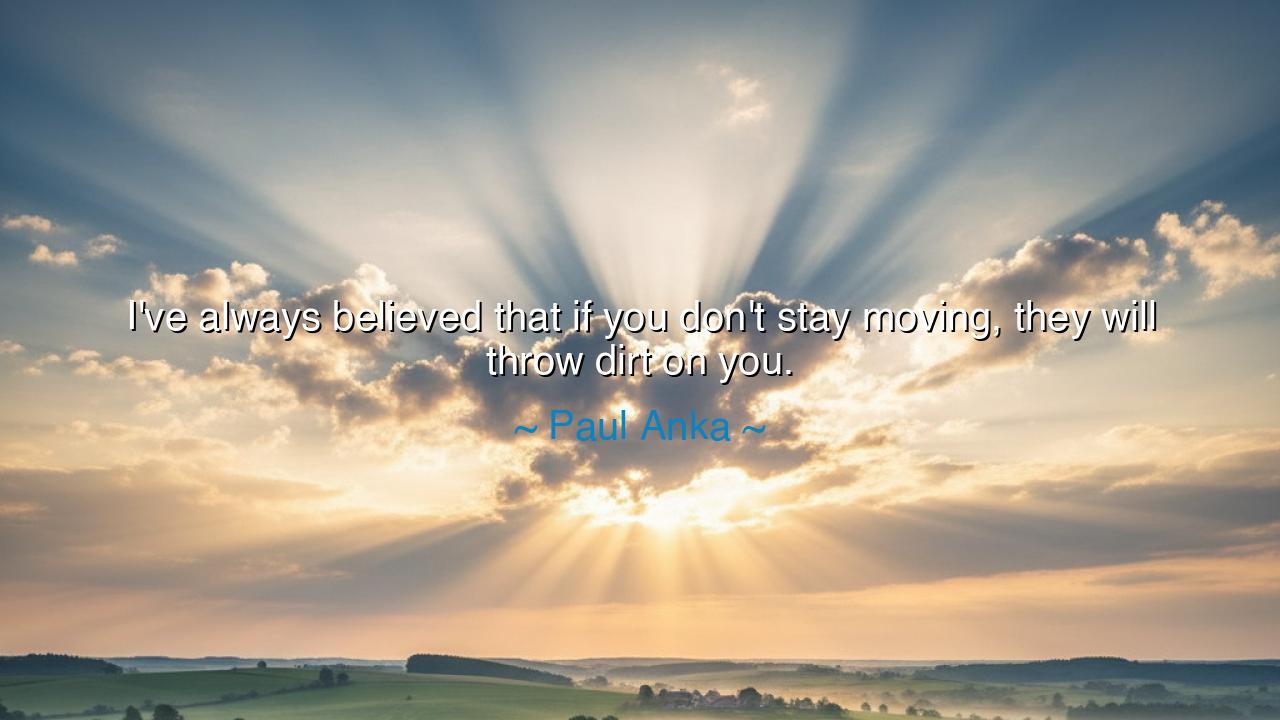
I've always believed that if you don't stay moving, they will






Hear the words of Paul Anka, singer and craftsman of enduring melodies, who declared with fierce simplicity: “I’ve always believed that if you don’t stay moving, they will throw dirt on you.” In this vivid saying lies the wisdom of one who has walked long in the world of performance and survival. To stay moving is not merely to remain in motion with the body, but to refuse stagnation of the soul. To stop, to rest too long, is to risk being buried—not by time alone, but by those who wait to declare you finished.
The ancients, too, knew this truth well. They spoke of life as a river, ever-flowing, never still. Heraclitus declared, “You cannot step into the same river twice,” for both you and the waters have changed. To stop moving is to resist the current of existence, and in resisting, one becomes overwhelmed. Anka’s words echo this ancient voice: if you cease to grow, to strive, to create, the world itself will treat you as though you are already gone. Dirt becomes a symbol not only of death, but of obscurity, irrelevance, and forgetfulness.
Consider the story of Julius Caesar. His strength was not merely in conquest, but in constant motion—crossing rivers, marching armies, seizing opportunities with relentless energy. Even when his enemies conspired against him, they did so because he never allowed himself to stagnate. He was ever-moving, ever-shaping the destiny of Rome. The moment he stopped—on the Ides of March—was the moment others cast dirt upon him, both literally and figuratively. His life illustrates Anka’s point: in movement lies vitality, in stillness lies danger.
Yet the saying is not only about rulers or artists—it speaks to every soul. For how often does a man or woman, after some triumph, rest too long in comfort, only to find that the world has passed them by? In work, in love, in dreams, to pause indefinitely is to surrender to the slow burial of time. The one who keeps moving—learning, adapting, seeking, daring—remains alive, not only in body but in spirit.
History gives us another light in the figure of Thomas Edison. He failed thousands of times in his experiments, yet he never stopped moving. Had he surrendered after one failure, he would have been buried beneath ridicule and dismissal. But his relentless striving made him a name spoken across centuries. His secret was the same that Anka proclaims: the grave comes soon enough—why help it by ceasing to move before your time?
The lesson, O seeker, is this: life rewards momentum. Do not allow yourself to be paralyzed by fear, by comfort, or by the judgment of others. If you feel the weight of dirt being thrown upon your dreams, rise and shake it off through motion. Begin again, adapt, reinvent yourself if needed—but never accept the stillness of defeat. To move is to live, to create, to remain beyond the reach of premature burial.
Practical steps are these: each day, take at least one step forward in some aspect of your life, however small. If you are weary, let your movement be gentle, but let it be real. Learn something new, strengthen your body, craft with your hands, speak words of love or encouragement. When obstacles block you, move around them. When critics bury you in scorn, use their dirt as the ground from which you rise higher.
Thus remember Anka’s wisdom: “If you don’t stay moving, they will throw dirt on you.” The world is quick to bury those who surrender to stillness. But for the soul that keeps moving, no mound of dirt can hold them. Stay in motion, in growth, in renewal, and you will not merely survive—you will live with the fire of one who refuses the grave until the very end.






AAdministratorAdministrator
Welcome, honored guests. Please leave a comment, we will respond soon